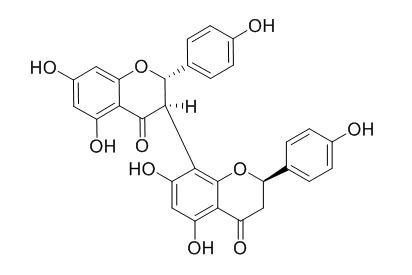GB 1a
GB 1a shows potential in vitro antioxidant activities.
Inquire / Order:
manager@chemfaces.com
Technical Inquiries:
service@chemfaces.com
Tel:
+86-27-84237783
Fax:
+86-27-84254680
Address:
1 Building, No. 83, CheCheng Rd., Wuhan Economic and Technological Development Zone, Wuhan, Hubei 430056, PRC
Providing storage is as stated on the product vial and the vial is kept tightly sealed, the product can be stored for up to
24 months(2-8C).
Wherever possible, you should prepare and use solutions on the same day. However, if you need to make up stock solutions in advance, we recommend that you store the solution as aliquots in tightly sealed vials at -20C. Generally, these will be useable for up to two weeks. Before use, and prior to opening the vial we recommend that you allow your product to equilibrate to room temperature for at least 1 hour.
Need more advice on solubility, usage and handling? Please email to: service@chemfaces.com
The packaging of the product may have turned upside down during transportation, resulting in the natural compounds adhering to the neck or cap of the vial. take the vial out of its packaging and gently shake to let the compounds fall to the bottom of the vial. for liquid products, centrifuge at 200-500 RPM to gather the liquid at the bottom of the vial. try to avoid loss or contamination during handling.
BMC Plant Biol.2022, 22(1):128.
Journal of Mushroom2023, 21(4):215-221.
Front Pharmacol.2017, 8:673
J Biochem Mol Toxicol.2020, 34(7):e22489.
Appl. Sci.2020, 10(23), 8729
Pharmacognosy Magazine2017, 13(52):868-874
iScience.2024, 4790628.
J Pharm Pharmacol.2023, 75(9):1225-1236.
Mol Med Rep.2024, 29(2):26.
Front Pharmacol.2022, 13:806869.
Related and Featured Products
Nat Prod Res. 2016;30(2):232-6.
Phytochemical analysis and antioxidant potential of the leaves of Garcinia travancorica Bedd.[Pubmed:
25982126 ]
METHODS AND RESULTS:
Phytochemical analysis of the leaves of Garcinia travancorica, a hitherto uninvestigated endemic species to the Western Ghats of south India, resulted in isolation and characterisation of the polyisoprenylated benzophenones 7-epi-nemorosone (1) and garcinol (2) along with biflavonoids GB 1a (3), GB-1 (4), GB-2 (5), morelloflavone (6) and morelloflavone-7″-O-β-D-glycoside or fukugiside (7). The compounds were identified using various spectroscopic techniques, mainly through NMR and MS. The methanol extract and the biflavonoids 3, 4, 5 and 7 showed potential in vitro antioxidant activities. The IC50 value of the 2,2-diphenyl-1-picrylhydrazyl (DPPH) radical scavenging activity of compound 7 was 8.34 ± 2.12 μg/mL, comparable to that of standard ascorbic acid (3.2 ± 0.50 μg/mL). In the superoxide radical scavenging assay, compound 7 gave IC50 value of 6.95 ± 1.33 μg/mL close to standard ascorbic acid with IC50 value of 5.8 ± 0.25 μg/mL.
CONCLUSIONS:
Validated HPTLC estimation revealed G. travancorica as a rich source of morelloflavone-7″-O-β-D-glycoside (7.12% dry wt. leaves).
J Chromatogr A. 2007 Jun 1;1151(1-2):45-50.
Preparative isolation and identification of tyrosinase inhibitors from the seeds of Garcinia kola by high-speed counter-current chromatography.[Pubmed:
17367799 ]
In continuation of our search for bioactive natural products that can be used for the treatment of dermatological disorders associated with melanin hyperpigmentation, 50 extracts/fractions from 21 families of medicinal plants from West and Central Africa were evaluated for inhibitory activity against tyrosinase (E:C:1.14.18.1), the rate-limiting enzyme in melanin synthesis.
METHODS AND RESULTS:
Four extracts including the methanol extract of Garcinia kola seeds at 100 microg/ml displayed >60% inhibition of tyrosinase activity. Preparative high-speed counter-current chromatography with solvent system composed of n-hexane-ethyl acetate-methanol-water (3:5:3:5) successfully separated the most active extract from G. kola seed. By stepwise increase of the flow-rate of the mobile phase, five major biflavanones including GB-I-glucoside (1) GB 1a (2), GB-1 (3), GB-2 (4), kolaflavonone (5) were successfully isolated in 6 h.
CONCLUSIONS:
Compound (4) was the most potent (IC(50) 582 microM) and compared favorably with a reference tyrosinase inhibitor (kojic acid, IC(50) 130 microM).



